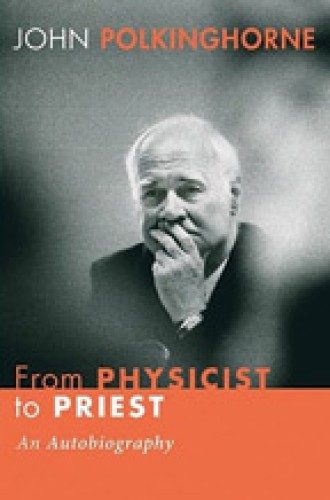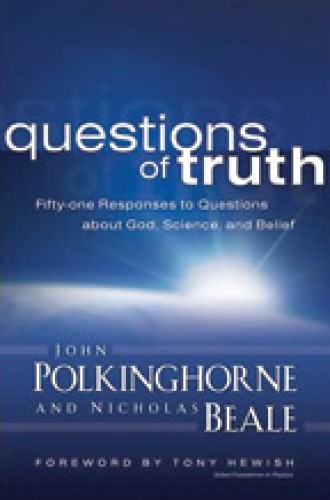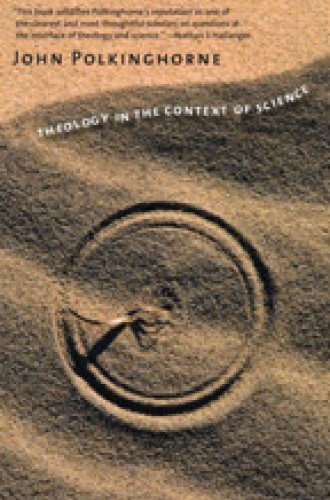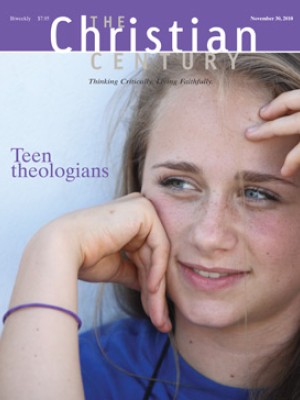Unseen realities
John Polkinghorne remembers the day when some of his colleagues thought he had lost his mind. He was already famous as a physicist for his work in helping explain the existence of quarks and gluons, the smallest known particles. He had been selected to be a member of England's Royal Society, one of the highest honors that can be bestowed on a scientist. His students at Cambridge University had moved into leading roles in scientific research.
It was the end of the academic year, and he and some other professors had gathered in his office for a brief meeting. At the conclusion, they gathered their papers, ready to leave.
"Before you go," Polkinghorne said, "I have something to tell you. I am leaving the university to enter the priesthood. I will be enrolling in seminary next year."
There was stunned silence in the room for several seconds, then murmuring, some of it kindly and supportive. The lone Scotsman in the audience, an atheist, was both wistful and wary: "You don't know what you're doing," he said. Others later wondered if Polkinghorne was committing intellectual suicide.
Read our latest issue or browse back issues.
In the years following this decision to leave the physics world, where he specialized in one kind of unseen realities, and enter the spiritual world, where he explored other unseen realities, Polkinghorne has become one of the most significant spokesmen for finding points of connection, not conflict, between faith and science.
He has written more than 30 books on theology and science and served on national boards to determine ethical standards for scientific research. He was knighted for his contributions in ethics and science. He is the founding president of the International Society for Science and Religion. He was awarded the Templeton Prize for his work on the relationship between science and religion. He was featured on the Science Channel in the U.S. for the program "Through the Wormhole," narrated by actor Morgan Freeman.
Polkinghorne discusses his vocational shift in his 2007 autobiography, From Physicist to Priest. Throughout the book he makes it clear that he has never seen how science and faith could be in conflict. He embraces and embodies both.
From Physicist to Priest traces Polkinghorne's life from childhood to retirement (he turned 80 this past fall). He grew up with Christian parents, lost a brother to World War II, and sensed a moment of spiritual deepening as a Cambridge student during a Christian Union service. His Christian Union affiliation didn't last long, as he discovered "a narrowness in the attitude that was inculcated, an encouragement of unnecessary inhibitions that fell short of the fullness and freedom of the Christian life." Moreover, "there was a certain bleakness that seemed to be expected of the faithful, which cast something of a shadow. I detect also there having been a degree of fearfulness about encounters with other points of view, including those of other Christian traditions, from whose shackles I am glad that eventually I found release."
Years later, at the height of his scientific achievement, Polkinghorne said, his mind "turned in the quite different direction of seeking to enter the ordained ministry of the Church of England. . . . Becoming a minister of word and sacrament would be a privileged vocation that held out the possibility of deep satisfaction."
He had been part of a neighborhood Bible study, which further solidified this sense of calling. He discussed the idea with his wife, Ruth, and with some close friends. They prayed for direction, and "over a period of a few months the idea of my seeking ordination seemed clearly to be the right way ahead."
One thing that did not change, he said, from the first half of his life to the next, was his search for truth. In both science and religion he moves from evidence to interpretation to motivated belief or conclusion—a process he calls "bottom-up thinking." It is the kind of thinking that physicists use as well.
Polkinghorne describes himself as a "humdrum Christian," but when he would visit the sick in the hospital and pray with them, he did not leave his intellectual, scientific self behind. The questions remained. "I did not suppose that all whom I visited would miraculously be cured. So what was one doing when one prayed? I concluded that what I was seeking was to help bring them and their suffering into the presence of God."
From Physicist to Priest is the only book of Polkinghorne's in which he addresses his personal life and events that shaped him. His other books focus on cosmic questions and scientific topics. He addresses some of these matters in question-and-answer format in Questions of Truth: Fifty-one Responses to Questions about God, Science, and Belief, written with Nicholas Beale. The authors discuss evil, the Trinity, evolution, the big-bang theory, Adam and Eve, intelligent design, atheism, the resurrection, salvation, eternity and other issues in which it might seem that religion is pitted against science.
Regarding evil, especially as it seems to appear in a natural disaster like a tsunami, Polkinghorne says, "It would be foolish to suppose that there is some simple one-line response to so deep a mystery, but there are some things that can be said, and science helps us to some degree in tackling the problem." Since he sees the universe as being in the process of "making itself"—in other words, evolving—"there is an inescapable shadow side to the evolutionary process. It will yield not only great fruitfulness, but there will also necessarily be ragged edges and blind alleys." The development of the earth, he says, is driven by mutation.
Had we been in charge of creation, he says, we like to think we would have done it better, keeping the sunsets and flowers and leaving out the diseases and disasters. "Science shows us that this is just not possible. The processes of the world are so intricately intertwined that one cannot separate the good from the bad, keeping the one and discarding the other. It is a package deal."
On the topic of evolution, Polkinghorne is clear: "A belief in evolution does not imply atheism," he says. "The idea that the religious establishment opposed Darwin is a complete fabrication." The process by which we have come into being is the way "creatures can explore God-given potentiality in a process by which they are allowed to 'make themselves.'"
Atheists have a faith of their own, Polkinghorne argues. It may be a faith in selfish competition, in Marxism, or in freedom to live as one pleases without responsibility, but it contains elements of religious faith. "The clear human need for some kind of faith can also lead to exaggerated emphasis on some prophets and seers of atheism, and a desire for sacred texts may partly explain the high sales of certain popular books," he says. "But in Christianity, at least, faith is a matter of love and a personal relationship, and there is no one at the heart of atheism that can take the place of God."
A common theme in this accessible book is one that emerges in personal conversation with Polkinghorne and is captured in the phrase, "But that's not the whole story." Science, life, God, the universe, are always surprising us with something else—or Something Else. After many years of research and reflection, Polkinghorne is comfortable with the posture that there is always more—to everything.
A more detailed discussion of some of these topics appears in his 2009 book Theology in the Context of Science. For example, he treats suffering as part of the price humanity pays for a world that is still in the process of freely creating itself; it is evidence of God's free will at work. Polkinghorne is not a deist, placing God at the beginning of time and then backing off to see how it all goes. He sees God as continuously emptying himself in love, allowing the universe to evolve freely, being present in grace, while allowing for mutations and dark alleys he mentions elsewhere.
Similarly, "The existence of tectonic plates leads to earthquakes when they slip, but the gaps between the plates also allow mineral resources to well up from within the Earth, affording a necessary replenishment of its surface fertility." This explanation doesn't remove the anguish or damage from how we think about disease and disaster, but "it at least provides some degree of assistance that theology can draw upon from the context of science as it seeks to speak about the universe as God's creation."
When it comes to the resurrection, Polkinghorne employs his bottom-up thinking. Theories of quantum physics about the existence of quarks are similar to Christian thinking about the resurrection of Jesus. In both cases, Polkinghorne says, "something happened." The fact that no one has seen a quark is irrelevant to scientists who conduct experiments that posit their existence. Steven Weinberg, a Nobel Prize–winning physicist, said at a debate with Polkinghorne at the Smithsonian Institution, "We don't believe in quarks because we've seen them," he said. "We believe in quarks because the theories that have quarks in them work."
Polkinghorne points to the fact that there were accounts of Jesus' death and accounts of his being among his disciples and on the road to Emmaus days later. Women, who in that culture were not included as witnesses for anything serious, were quoted as the first to see the risen Jesus. Decades later it was still being discussed by Paul and others. If it had been a political stunt, it would have been debunked. Evidence points to interpretation, which leads to conclusions. Something happened.
After serving several parishes, Polkinghorne returned to Cambridge, first as a chaplain to one of the colleges and then as president of Queens' College, a position he held until he retired. He lives in Cambridge. He travels some to speak on faith and science issues—mostly in Europe and occasionally to North America.
Recently he was invited to return to Blean, his parish in the 1980s, where he wrote his most successful book, One World: The Interaction of Science and Theology (SPCK, 1986). Though he had been away for 25 years, people still came for counseling and advice.
One longtime parishioner said she was a little nervous when Polkinghorne first came to their parish as a new priest, because she knew he was a well-known scientist and she couldn't imagine how a scientist would be able to relate to her. His sermons were ten minutes long and did not include jokes, anecdotes about his family or references to current events; they stuck to the lectionary. A church official described his sermons as "brisk." They may have been brisk, but they were also accessible.
"I remember his first sermon," the parishioner said. "He said that everything we believe comes from our particular vantage point. He used an illustration of making a cup of tea."
The cup-of-tea illustration is one of Polkinghorne's most common analogies for explaining the importance of context. Why is the kettle of water boiling? It is because the gas underneath the stove was lit, creating a flame to excite the particles in the kettle, causing their temperature to rise, which in turn excites the particles in the water, causing their temperature to rise, bringing the water to boil. That's one answer.
Another answer might be that I put the kettle on the stove to make some tea—would you share a cup with me?
Both answers would be correct.
"He doesn't do all the work for you," another Blean parishioner said. "He'll discuss things with you and then say, 'You can do some of this thinking yourself, you know.'"
On this Sunday in Blean, Polkinghorne spoke on Jesus' words, "I am the bread of life," and explained that while Jesus is the bread that sustains us, we in turn are the bread to the world. The sermon was deep and brisk—like a good cup of life-giving tea.









